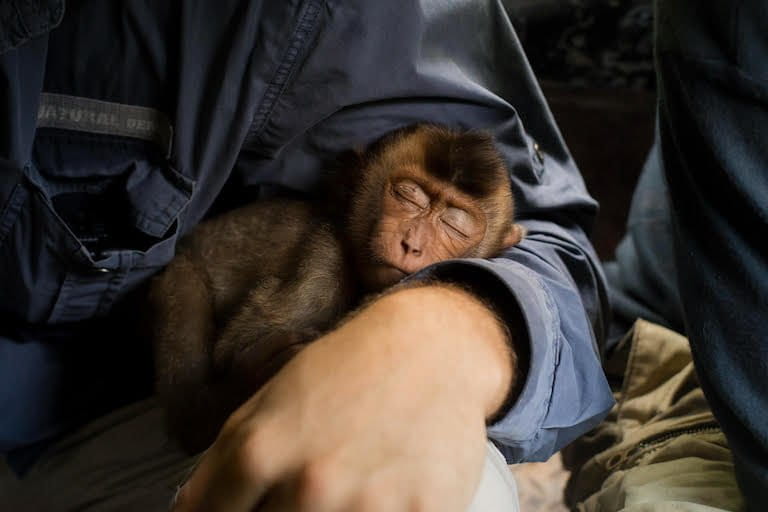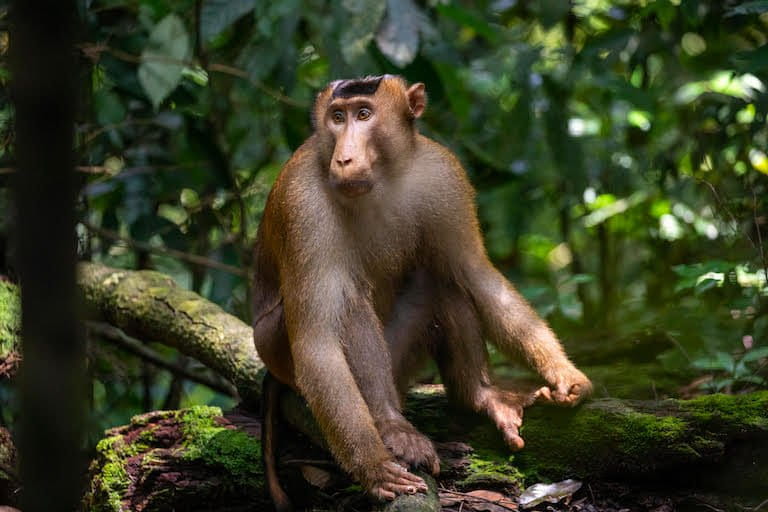- It is alarming if a highly adaptive generalist species such as the pig-tailed macaque–which can thrive even in oil palm landscapes–is now threatened with extinction, the author argues.
- Not long after rescuing an infant macaque from a life on a chain, the author discovered that this once common species has been listed as endangered.
- “Conservation has to include all wildlife regardless of their status. As we can see from the pig-tailed macaque, the common species of today can easily become the endangered species of tomorrow,” he says.
- This article is a commentary. The views expressed are those of the author, not necessarily Mongabay.
The southern pig-tailed macaque (Macaca nemestrina) has recently been re-classified as endangered by the IUCN (and even the long-tailed macaque is now considered Vulnerable). This news came as a surprise to my colleagues and me. Yet, it is alarming if a highly adaptive generalist species such as the pig-tailed macaque – which can thrive even in oil palm landscapes – is now threatened with extinction.
I write this not only because of the endangerment of once (and still now) ignored species such the pig-tailed macaque, but also because of my personal connection to a particular individual, and his story.
In May 2019, at the beginning of a biodiversity survey in a remote area in North Sumatra known as “Hadabuan Hills,” I encountered a chained-up baby pig-tailed macaque in the village where we started our expedition. I couldn’t ignore the little guy and the villagers agreed to hand him over to me, to the dismay of my team, as it meant that an annoying little macaque would be joining our 10-day survey.

His mother was killed during a conflict with local farmers and put on a short chain. I named him Achilles, and the term ‘cheeky monkey’ was a perfect fit for him. He kept the entire team on their heels, and he kept me awake at night. After the 10-day forest adventure, where he showed remarkable skills in catching crickets and moths as well as stealing our food, I needed to find a rehabilitation center for him.
Luckily, Kalaweit in West Sumatra took him in, where he joined a group of other pig-tailed macaques, and where he is on the way to be released.
Achilles is one of the rare lucky ones that get rescued. Around Sumatra there are likely thousands of pig-tailed macaques kept on chains and trained for collecting coconuts. They live their life being abused by people, and with (at best) a one-meter metal chain or a rope around their neck or waist. Although legally protected in Indonesia, it is pointless to confiscate them as there is nowhere to put the confiscated macaques. This is now an endangered species that is openly sold in markets and kept as a pet. Further, local communities regard them as a crop-raiding pest, and they are quickly shot dead. The infant that is left behind is then taken and sold.
I remember when I was carrying around Achilles and my team did not understand why I bothered to rescue a pig-tailed macaque as it is not an endangered gibbon or critically endangered orangutan. I said regardless of being endangered or not they deserve better, and also one day they could be endangered.
Everyone laughed as nobody would have thought that one year later the IUCN would list them as endangered. This should be an alarming sign that shows how far off we are in reaching our conservation goals and that our efforts do not match the severity of the current extinction crisis.
Why are we only focusing on the conservation needs of a species once they are pushed to the endangered status? Extremely limited funding forces us to choose priority species based on their endangerment, while the species that are still common are ignored until they become endangered themselves. Once abundant and common species can vanish, just as it happened to the passenger pigeon.

We are now losing species at an alarming rate, and species that were common not too long ago are now also facing an uncertain future as habitats are bulldozed, remaining habitat fragments are bombarded with snares, and in landscapes where humans dominate, wildlife is seen as a pest to be killed.
Conservation has to include all wildlife regardless of their status. As we can see from the pig-tailed macaque, the common species of today can easily become the endangered species of tomorrow. Around the world wildlife populations are buckling and ecosystems are collapsing due to our exploitive quest for more. The consequence will be a drastically impoverished biosphere with cascading effects that will bring human society to its knees.
If we do not wake up now and drastically change the way we as a society interact with other life forms, then Karma will have its way and we will be endangered. Maybe not as a species, but as society as a whole, due a drastic drop in wellbeing and changes in daily life as we know it, once planetary boundaries are reached and ecosystems that we depend upon collapse.
See related by Sinan Serhadli: Market-based solutions cannot solely fund community-level conservation

The situation is especially bad in the tropics due to the lack of law enforcement—a situation which allows the illegal wildlife trade to flourish—as well as rapid economic development, little political will for conservation, and greater dependency on ecosystems for people’s livelihoods.
In the “developed” world or the Global North we have already wiped out most of the megafauna hundreds of years ago (not counting the Pleistocene Extinction) and converted most of nature into agricultural deserts, industrial complexes, roads, and urban areas.
An example of a once very abundant and common species in Europe and that is now critically endangered is the European field hamster. We are literally pushing life on Earth to the brink, and if pig-tailed macaques are already endangered, then I wonder what is next?
If we continue, we will “live” on a planet that does not support current abundance of life, but rather where we have to tell our grandkids how we let greed destroy paradise, and wiped out everything that could not withstand our ecocidal onslaught.
Sinan Serhadli is an adviser on conservation and livelihood development programs across Southeast Asia for the People Resources and Conservation Foundation.













